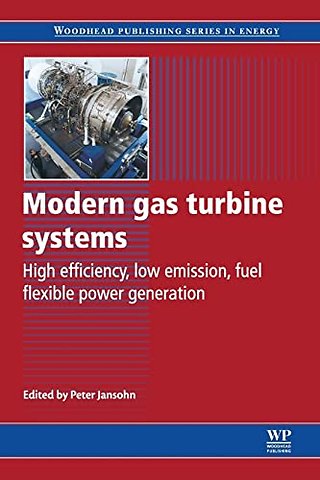<p>Contributor contact details</p> <p>Woodhead Publishing Series in Energy</p> <p>Part I: Overview of modern gas turbine systems</p> <p>Chapter 1: Introduction to gas turbines</p> <p>Abstract:</p> <p>1.1 Introduction</p> <p>1.2 The importance of gas turbines for worldwide CO2 reduction</p> <p>1.3 Importance of gas turbines for the aviation sector</p> <p>1.4 Importance of gas turbines for the power generation sector</p> <p>1.5 Efficiency improvement: impact on other issues</p> <p>1.5.1 Total life cycle costs: importance of efficiency measures</p> <p>1.5.2 Technologies for improved gas turbine and system efficiency</p> <p>1.6 Other trends in gas turbine technology</p> <p>1.7 Market trends</p> <p>1.8 Conclusion</p> <p>Chapter 2: Overview of gas turbine types and applications</p> <p>Abstract:</p> <p>2.1 Introduction</p> <p>2.2 Gas turbine types by application</p> <p>2.3 Power generation</p> <p>2.4 Aero-engines</p> <p>2.5 Industrial turbines</p> <p>2.6 Microturbines</p> <p>2.7 Advantages and limitations</p> <p>2.8 Future trends</p> <p>Chapter 3: Fundamentals of gas turbine cycles: thermodynamics, efficiency and specific power</p> <p>Abstract:</p> <p>3.1 Introduction</p> <p>3.2 Thermodynamic properties of gases</p> <p>3.3 The Joule–Brayton cycle</p> <p>3.4 Improvements to the simple cycle</p> <p>3.5 Combined gas–steam cycles</p> <p>3.6 Basics of blade cooling</p> <p>3.7 Conclusion and future trends</p> <p>Part II: Modern gas turbine systems and major components</p> <p>Chapter 4: Compressors in gas turbine systems</p> <p>Abstract:</p> <p>4.1 Introduction: role of the compressor</p> <p>4.2 Types of compressor systems</p> <p>4.3 Stationary gas turbine compressor elements</p> <p>4.4 Compressor characteristic parameters</p> <p>4.5 Operational requirements inside a gas turbine</p> <p>4.6 Compressor design process</p> <p>4.7 Technological trends and special features</p> <p>4.8 Acknowledgement</p> <p>4.10 Appendix: variables and indexes</p> <p>Chapter 5: Combustors in gas turbine systems</p> <p>Abstract:</p> <p>5.1 Introduction</p> <p>5.2 Design principles</p> <p>5.3 Combustor operation</p> <p>5.4 Fuel flexibility</p> <p>5.5 Future trends</p> <p>Chapter 6: Turbines for industrial gas turbine systems</p> <p>Abstract:</p> <p>6.1 Introduction</p> <p>6.2 Interfaces and integration</p> <p>6.3 Aerodynamics</p> <p>6.4 Cooling</p> <p>6.5 Durability and damage mechanisms</p> <p>6.6 Typical parts and interfaces</p> <p>6.7 Future trends</p> <p>Chapter 7: Heat exchangers and heat recovery processes in gas turbine systems</p> <p>Abstract:</p> <p>7.1 Introduction</p> <p>7.2 Heat exchange processes</p> <p>7.3 Heat transfer equipment</p> <p>7.4 Applications</p> <p>7.5 Future trends</p> <p>7.6 Conclusion</p> <p>7.10 Appendix: nomenclature</p> <p>Chapter 8: Turbogenerators in gas turbine systems</p> <p>Abstract:</p> <p>8.1 Introduction</p> <p>8.2 Generator component design</p> <p>8.3 The history of turbogenerator development</p> <p>8.4 Design concepts of turbogenerators for modern gas turbines</p> <p>8.5 Turbogenerator development for gas turbines</p> <p>8.6 Recent developments</p> <p>8.7 Future trends</p> <p>8.8 Acknowledgement</p> <p>Chapter 9: Materials and coatings developments for gas turbine systems and components</p> <p>Abstract:</p> <p>9.1 Introduction</p> <p>9.2 Turbine parts</p> <p>9.3 Combustor parts</p> <p>9.4 Coatings for hot gas path parts</p> <p>9.5 Ceramics for hot gas path parts</p> <p>9.6 Rotor parts</p> <p>9.8 Appendix: nomenclature</p> <p>Part III: Operation and maintenance of modern gas turbine systems</p> <p>Chapter 10: Gas turbine operation and combustion performance issues</p> <p>Abstract:</p> <p>10.1 Introduction</p> <p>10.2 Flame stabilisation mechanisms</p> <p>10.3 Emissions variations</p> <p>10.4 Combustion dynamics</p> <p>10.5 Future trends</p> <p>Chapter 11: Gas turbine performance modelling, analysis and optimisation</p> <p>Abstract:</p> <p>11.1 Introduction</p> <p>11.2 Design-point modelling of gas turbine cycles</p> <p>11.3 Steady flow energy equation</p> <p>11.4 The ideal simple gas turbine cycle</p> <p>11.5 Reversibility and efficiency</p> <p>11.6 Thermophysical properties of air and products of combustion</p> <p>11.7 Thermodynamic modelling of gas turbine components applicable for practical gas turbine cycles</p> <p>11.8 Determining component performance using specific heats</p> <p>11.9 Design-point performance modelling, analysis and performance optimisation of practical (shaft power) gas turbines</p> <p>11.10 Design-point performance modelling of aero gas turbines, analysis and optimisation</p> <p>11.11 Component characteristics</p> <p>11.12 Engine configurations</p> <p>11.13 Off-design performance prediction</p> <p>11.14 Transient performance modelling</p> <p>11.15 Off-design performance behaviour of gas turbine cycles</p> <p>11.16 Adaptive model-based control</p> <p>11.17 Future trends</p> <p>Chapter 12: Advanced gas turbine asset and performance management</p> <p>Abstract:</p> <p>12.1 Introduction</p> <p>12.2 Gas turbine degradation</p> <p>12.3 Hot gas path management</p> <p>12.4 Centre for remote monitoring and diagnostics (CMD)</p> <p>12.5 E-maintenance and future trends</p> <p>12.6 Key definitions</p> <p>12.7 Acknowledgement</p> <p>Chapter 13: Maintenance and repair of gas turbine components</p> <p>Abstract:</p> <p>13.1 Introduction</p> <p>13.2 Maintenance factors</p> <p>13.3 Outage cycle</p> <p>13.4 Advanced component repair technology</p> <p>13.5 Compressor cleaning</p> <p>13.6 Future trends</p> <p>13.7 Acknowledgement</p> <p>Chapter 14: Fuel flexibility in gas turbine systems: impact on burner design and performance</p> <p>Abstract:</p> <p>14.1 Introduction</p> <p>14.2 Primary fuel characterization</p> <p>14.3 Fuels directly introduced into gas turbine burners</p> <p>14.4 Integrated gasification combined cycle (IGCC) technology options with and without air-side integration and carbon capture and storage (CCS)</p> <p>14.5 Characterizing fuel gases</p> <p>14.6 Measures for extending operation range for fuel gases</p> <p>14.7 Characterizing liquid fuels</p> <p>14.8 Future trends</p> <p>Chapter 15: Carbon dioxide (CO2) capture and storage for gas turbine systems</p> <p>Abstract:</p> <p>15.1 Introduction</p> <p>15.2 CO2 capture technologies</p> <p>15.3 Impact of carbon capture and storage (CCS) on current gas turbines</p> <p>15.4 Novel approaches</p> <p>15.5 Implementation of carbon capture and storage (CCS) for gas turbines</p> <p>15.6 Conclusion</p> <p>15.7 Acknowledgements</p> <p>Chapter 16: Ultra-low nitrogen oxides (NOx) emissions combustion in gas turbine systems</p> <p>Abstract:</p> <p>16.1 Introduction</p> <p>16.2 The NASA clean combustor programme</p> <p>16.3 Acoustic resonance and catalytic combustion</p> <p>16.4 Thermal NOx formation</p> <p>16.5 Prompt NOx</p> <p>16.6 Predictions of thermal NOx</p> <p>16.7 Influence of mixing on thermal NOx</p> <p>16.8 Impact of fuel-and-air mixing quality on thermal NOx emissions</p> <p>16.9 Influence of air inlet temperature</p> <p>16.10 Influence of residence time in premixed combustion: reference velocity and reference Mach number</p> <p>16.11 Conclusions</p> <p>16.12 Acknowledgements</p> <p>Index</p>
